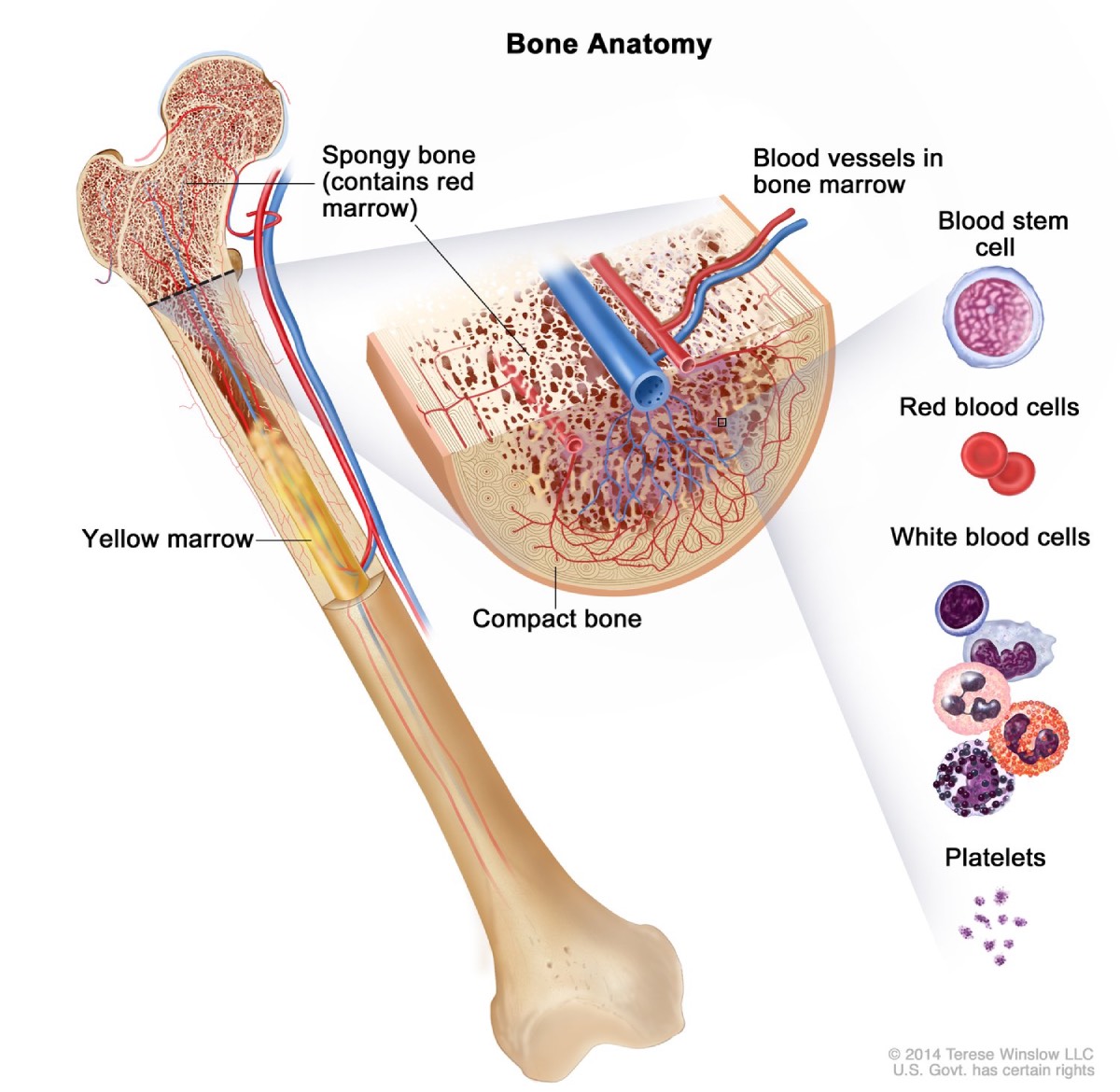Definition & Facts for Aplastic Anemia & Myelodysplastic Syndromes
In this section:
- What are aplastic anemia and myelodysplastic syndromes?
- Are there other names for aplastic anemia and MDS?
- How common are aplastic anemia and MDS?
- Who is more likely to develop aplastic anemia or MDS?
- What are the complications of aplastic anemia and MDS?
What are aplastic anemia and myelodysplastic syndromes (MDS)?
Aplastic anemia and myelodysplastic syndromes (MDS) are rare but serious disorders that affect bone marrow and blood. Bone marrow is the soft, sponge-like tissue inside your bones. Your bone marrow contains blood stem cells, which make of all the red blood cells, white blood cells, and platelets carried around in your blood. In both aplastic anemia and MDS, your bone marrow is injured and doesn’t produce enough healthy blood cells, which leads to lower than normal levels of at least two of the three blood cell types.
Each of the three types of blood cells—all made in the bone marrow—performs an important job.
- Red blood cells contain hemoglobin, which is a protein that carries oxygen from your lungs to all parts of your body. Having fewer red blood cells than normal is called anemia.
- White blood cells are an important part of your immune system, helping your body fight infections. Having fewer white blood cells than normal is called leukopenia.
- Platelets are small blood cells that stick together to stop bleeding and help wounds heal. Having fewer platelets than normal is called thrombocytopenia.
In aplastic anemia, many of your bone marrow’s stem cells are injured or destroyed. With fewer stem cells, your bone marrow cannot produce an adequate number of blood cells, though the cells that are produced are healthy. In MDS, some of your bone marrow’s stem cells are damaged and produce unhealthy blood cells that do not work properly, leaving you without enough working, mature blood cells.

Are there other names for aplastic anemia and MDS?
Aplastic anemia and MDS are types of bone marrow failure. MDS is sometimes called myelodysplasia or preleukemia.
How common are aplastic anemia and MDS?
Aplastic anemia is rare. About 2 out of every 1 million people in the United States are diagnosed with aplastic anemia each year.1
Myelodysplastic syndromes are also rare, especially in people younger than age 60. The risk of developing MDS increases as people age, so the total number of MDS cases is likely to grow as the U.S. population ages.2
Who is more likely to develop aplastic anemia or MDS?
Aplastic anemia
Aplastic anemia can affect people of any age, but it’s more likely to develop between the ages of 2 to 5, 20 to 25, and 55 and older.3 The disorder affects men and women equally.1
Your risk of developing aplastic anemia is higher with1
- a history of autoimmune disorders
- a history of viral infection, such as hepatitis
- pregnancy
- the use of certain medicines, such as sulfonamides and antiseizure medications
- long-term exposure to pesticides and certain chemicals, such as benzene
- certain inherited bone marrow failure syndromes, such as Fanconi’s anemia and Shwachman-Diamond’s syndrome
MDS
MDS can occur at any age, but your risk for developing the disease increases as you get older. The disorder is most common in people ages 60 and older, and it affects men about twice as often as women.4
Your risk for MDS is higher with5
- long-term exposure to certain chemicals, including benzene, pesticides, and tobacco
- a history of radiation or chemotherapy treatments for cancer
- certain inherited bone marrow failure conditions, such as Fanconi’s anemia, Diamond-Blackfan anemia, and dyskeratosis congenita
What are the complications of aplastic anemia and MDS?
Aplastic anemia and MDS can be life-threatening. Too few healthy red blood cells can lead to severe anemia and heart failure because your body isn’t getting enough oxygen. When your body doesn’t make enough healthy white blood cells, you are at risk of developing severe infections. Without enough healthy platelets, you can experience spontaneous internal bleeding.
People with aplastic anemia or especially MDS are at greater risk of developing acute myeloid leukemia, a blood cancer that affects the bone marrow.
References
This content is provided as a service of the National Institute of Diabetes and Digestive and Kidney Diseases
(NIDDK), part of the National Institutes of Health. NIDDK translates and disseminates research findings to increase knowledge and understanding about health and disease among patients, health professionals, and the public. Content produced by NIDDK is carefully reviewed by NIDDK scientists and other experts.
